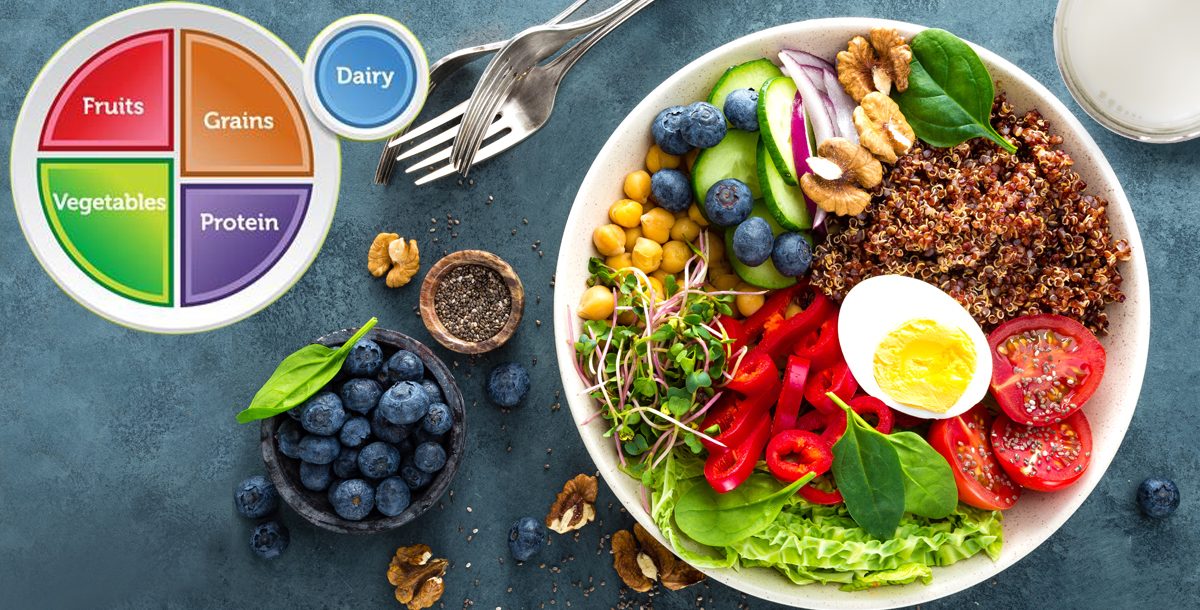Since 1916, the United States Department of Agriculture (USDA) has been providing science-based guidance on healthy eating choices. What we learned as the food pyramid in the 1990s and 2000s has been replaced with MyPlate.
MyPlate focuses on:
- Making small changes in your diet for healthier living
- Including all healthy foods and beverages in your diet
- Creating a healthy-eating lifestyle to fit each stage of life
What’s MyPlate?
MyPlate is an easy way to see what foods you should eat to get the nutrition your body needs to stay healthy. It shows you how much you should eat each day of:
- Dairy
- Fruits
- Grains
- Vegetables
- Protein foods
Half of your plate should be filled with fruits and vegetables. The other half is grains and protein foods. Dairy is on the side as a serving next to your plate. MyPlate also focuses on choosing foods and drinks that are low in sodium, saturated fats, and added sugars.
How to build a healthy plate
To build your healthy plate, focus on variety, nutrition and amount. Also, keep the following tips in mind.
Vary your veggies. Vegetables are full of minerals and vitamins. You can eat them cooked or raw and mix them in other foods such as omelets and wraps. Vegetables are grouped into five types, and eating healthily means choosing from each group:
- Starchy vegetables, like corn, potatoes and parsnips
- Red and orange vegetables, such as carrots, tomatoes and squash
- Beans and peas, such as black-eyed peas, kidney beans and lentils
- Dark green vegetables, including broccoli, spinach and romaine lettuce
- Other vegetables, including avocado, cucumbers, green beans and zucchini
Focus on whole fruits. When you eat whole fruits instead of just the juice, you get the added benefits of fiber as well as more vitamins and minerals. Fruits are healthy substitutes for sweet snacks and eating them may lower your risk of some diseases. Fruits that are fresh, frozen, dried, or canned count as part of your healthy plate. For variety, choose fresh fruits when they’re in season, such as strawberries in the spring and apples in the fall.
Make half your grains whole grains. Whole grains are wheat, rice, oats, corn, and other grains in their natural form. They’re healthier than refined grains because they contain all three parts of the nutritious seed — the bran, germ, and endosperm. Refined or enriched grains only have the endosperm, so they’ve lost 25 percent of their protein and over 17 nutrients. You can find whole grains by looking for the “100% Whole Grain” stamp or words in the ingredients list such as “whole grain,” “whole wheat” and “brown rice.”
Move to low-fat or fat-free dairy. Dairy products are rich in vitamin D and calcium, which help your body build and maintain strong bones. However, choosing low-fat or fat-free dairy can keep you healthier. Dairy that’s high in saturated fat raises the “bad” cholesterol in your bloodstream, which can lead to heart problems.
Dairy foods on your healthy plate include:
- Milk
- Yogurt
- Cheese
- Fortified soymilk
- Non-dairy foods rich in calcium, such as fortified cereals, canned fish and almond milk
Vary your protein. Foods rich in protein are essential for healthy muscles, skin, bones, cartilage, and blood. Protein foods also contain important vitamins and minerals. To get the right amounts of nutrients, choose a variety of proteins:
- Eggs
- Seafood, including salmon, tuna and shellfish
- Meats, such as lean beef, pork and game meats
- Poultry, like chicken, turkey and Cornish game hen
- Beans and peas, including chickpeas, refried beans and tofu
- Nuts and seeds, such as walnuts, peanut butter and sunflower seeds
Additionally, the USDA’s website has handy tools that helps you build your healthy plate according to your age, height, weight, and activity level. Once you’ve determined your recommended daily calorie intake, you’ll get guidelines on how many cups or ounces of the five food groups you should
Learn more about the nutrition services offered at Bon Secours.





